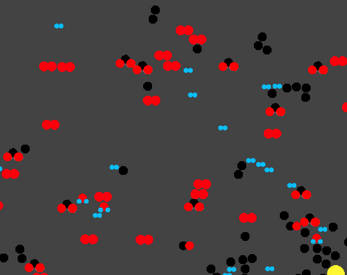Coal Combustion Simulation
Click the checkboxes to disable/enable the displays.
Science: Coal combustion is an extremely dirty way of producing energy. Coal is primarily made up of carbon, hydrogen, oxygen, nitrogen and sulfur and requires oxygen to combust. The result is a small amount of energy and very dangerous byproducts. Carbon dioxide contributes to man-made climate change and builds up in the atmosphere over time. Sulfur monoxide is also toxic and can lead to acid rain. Most of these toxic gases are uncontained and released into the atmosphere.
Model: This model simulates a combustion reaction with one mole of coal (each particle is scaled by 6.022 x 10^23 times to represent one mole of that particle). The coal type in the simulation is bituminous coal (formula used: C137H98S). Oxygen molecules are added to the system every five seconds and react with the coal to produce energy. The energy for each reaction is calculated using bond energy listed below*. Particle collision is rudimentarily calculated using elastic collision in two dimensions. The masses for each particle are calculated with its associated molar mass**.
Model Limitations: (1) The rudimentary particle collision can result in buggy collisions. (2) Nitrogen which makes up ~1% of bituminous coal is not shown. (3) The amount of oxygen added into the system is arbitrary. (4) This specific chemical formula of coal is a real-life example and thus cannot be generally applied to all bituminous coals. (5) Coal contains many other elements other than the ones modeled. While they are is often only negligible amounts, these other elements are often very harmful. (6) There are many other factors in a chemical reaction other than collision like the two particles' direction and velocity. This has been simplified to speed up the reaction.
How does it compare? Shockingly well. The energy produced in this system matches established estimates. One mole of bituminous coal should produce 51,000 - 58,000 kJ of energy and around 100 moles of CO2 as byproduct. The model follows these estimates.
* Chemical Reactions
- C + O2 → CO2 generates 393 kJ of heat
- H2 + 0.5 O2 → H2O generates 286 kJ of heat
- 2C+O2→ 2CO generates 283 kJ of heat
- S+O2→ SO2 generates 296 kJ of heat
**Equation: new_velocity = (((-self_velocity) * collider_mass) + (2 * collider_mass * collider_velocity) + (self_mass * self_velocity)) / (self_mass + collider_mass). This was derived from conservation of momentum formula and conservation of kinetic energy formula
Main Sources:
| Status | Prototype |
| Category | Other |
| Platforms | HTML5 |
| Author | spencerho777 |

Leave a comment
Log in with itch.io to leave a comment.